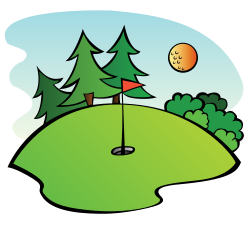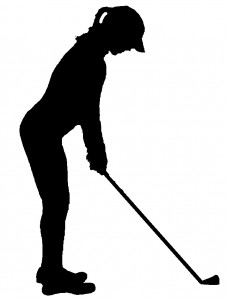 Golf is a great activity for amateur and professional golfers alike. It allows one to appreciate the outdoors, be active and challenge one’s skill/balance and co-ordination. Understandably frustrating at times, but overall a fun sport! Just imagine how much more frustrating it would be to not play on account of pain or injury…
Golf is a great activity for amateur and professional golfers alike. It allows one to appreciate the outdoors, be active and challenge one’s skill/balance and co-ordination. Understandably frustrating at times, but overall a fun sport! Just imagine how much more frustrating it would be to not play on account of pain or injury…
Chiropractic care is a safe and effective means to maximize your golf experience by treating and preventing common golf-related injury, improving flexibility and optimizing your body’s biomechanics. The purpose of this article is to provide information to help prevent golf injuries and on how to hasten recovery should one occur, for an earlier pain-free return to play.
Common Golf-Related Injury
Being a whole body activity, it is not surprising that a golf injury can involve any structure in the body including the low back, neck, shoulders, elbows, wrists, hips, knees or ankles! A full examination of each problem area as well as related structures is necessary to properly diagnose and treat the problem.
Since golf is a non-contact sport, overuse injuries are far more common than single traumatic events. Just think of the repetitive nature of the golf swing and the rotational forces that the body must go through! Muscle imbalance is very common in golfers because it is a very repetitive, one sided activity. In addition to the golf swing itself, the sport also requires walking on uneven surfaces, repetitive bending to retrieve the ball and manoeuvring a heavy golf bag.
Studies show that golf-related injury is far more common towards the beginning of golf season. This is why it is important to stay physically fit all year round.
Why Chiropractic for the Golfer?
Some common reasons for golfers to seek chiropractic care are as follows…
-
treatment of golf related injuries (for a more complete recovery and earlier pain-free return to play)
-
early detection of mechanical problems in asymptomatic individuals
-
prevention of sports related injury and possibly even improved performance
During an initial visit to a chiropractor, a health history and physical examination is done. The purpose is to fully understand the patient’s presenting concerns and overall health and then to objectively record any findings. A physical examination is likely to consist of an assessment of posture, flexibility of the spine and related joints, functional testing, muscle challenge and neurological testing. The information gathered is used to diagnose problems and to identify any areas of imbalance that may contribute to pain, injury and suboptimal performance.
Chiropractic treatment consists of hands-on care which may include muscle work and adjustments to the spine, pelvis or extremity joints for any identified problem areas. The goal is to restore optimal mechanics/function of the joints and to improve muscle function. Beyond this, exercises may be prescribed for improving muscle balance, golf posture and core strength. Core strengthening, endurance training, balance training and resistance exercises are all great golf-specific exercises both on and off-season.
If you think about the mechanics of the golf swing, it really involves the entire body. Flexibility and stability are both required. For complete rotation during the golf swing, flexibility is required for all joints including the spine, hips and shoulders. A restriction in the full range of motion at any one joint may cause undue stress to other joints (above and below the restricted area) as compensation patterns develop. This can result in irritation and pain over time. Chiropractic helps by ensuring that all joints are moving efficiently and there are no restrictions in the kinetic chain. It restores balance and optimal biomechanics.
Tips for Golf Injury Prevention
The Ontario Chiropractic Association recommends the following ten tips for golf injury prevention…
-
When lifting your golf bag, bend your knees and lift using your legs, not your back
-
Always warm up with a few minutes of aerobic activity, such as brisk walking
-
Stretch the muscles in your back, abdomen, legs and shoulders before your game
-
Use clubs that are the correct length, so you don’t have to bend or overextend your back
-
Wear soft spikes on your shoes for greater cushioning and shock absorption
-
Use a cart rather than carrying your clubs
-
Take some lessons on how to swing and choose the correct club.
-
Occasionally practice swinging in the opposite direction to balance the stress on the muscles in your back
-
Bend your knees and use a golf club for support when stooping to retrieve your ball
-
Always stretch to cool down after finishing a game
Other Helpful Tips for the Golfer
 Be aware of your body posture and position during the golf swing. The optimal starting position for the golf swing is a slight bend in the knees and hips and a neutral spine position. A neutral spine is achieved when the natural curves of the spine are maintained – including a slight backward curve in the low back and neck and a slight forward curve in the upper back. The neutral spine position is a strong, athletic, efficient and safe position for the back to be in. These curves should be maintained throughout the golf swing so that there is only rotation in the joints and no flexion/extension. Some researchers also suggest shortening of the back-swing to reduce spinal torsion/shearing as a back injury prevention strategy. In this situation, the shoulders and pelvis remain parallel for the majority of the swing.
Be aware of your body posture and position during the golf swing. The optimal starting position for the golf swing is a slight bend in the knees and hips and a neutral spine position. A neutral spine is achieved when the natural curves of the spine are maintained – including a slight backward curve in the low back and neck and a slight forward curve in the upper back. The neutral spine position is a strong, athletic, efficient and safe position for the back to be in. These curves should be maintained throughout the golf swing so that there is only rotation in the joints and no flexion/extension. Some researchers also suggest shortening of the back-swing to reduce spinal torsion/shearing as a back injury prevention strategy. In this situation, the shoulders and pelvis remain parallel for the majority of the swing.
Regular core strengthening exercises should be done both on and off-season. A strong core helps to protect the spine from injury by providing stabilization. The core muscles also provide a lot of the driving force for the golf swing.
Another consideration for the golfer is custom foot orthotics. The feet are one’s base of support, so faulty alignment at the feet can actually impact the rest of the body. One of the most common foot functional problems is over-pronation which can contribute to pain/irritation of the feet, knees, hips and even the back.
Dr. Elisabeth Miron